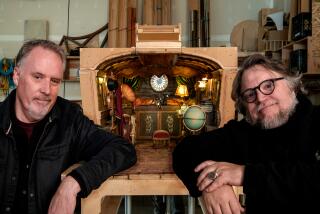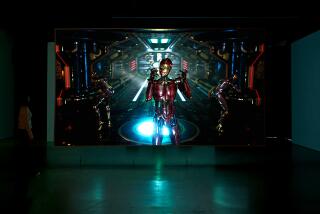Jon Favreau on his photorealistic ‘Jungle Book’ movie vs. the uncanny valley
Jon Favreau’s “Jungle Book” presentation premiered to a standing ovation this past weekend at the D23 expo in Anaheim. But will Favreau’s technique of blending photorealistic CG animation and live action pass the uncanny valley test? How will the director avoid this crucial CG problem?
Disney’s new “Jungle Book” movie is a mix of live action scenes and CG created characters and environments. “The uncanny valley” is the term given to computer generated creations that miss the mark and, instead of looking lifelike, look just wrong enough to confuse (and sometimes horrify) the audience. The 2007 Orville Redenbacher commercial is a pretty good marker of a computer-generated character stumbling head first into the uncanny valley.
This is a big hurdle for many performance-capture movies chasing the photorealistic look. We asked Favreau if he was worried about creating talking animals without falling into the uncanny valley, and his response opened an interesting window into how his movie was being filmed.
SIGN UP for the free Indie Focus movies newsletter >>
“It’s a lot easier with animals than people,” Favreau said. “The uncanny valley pops up when, usually it’s the facial recognition part of your brain starts to shear, because it’s watching weird things happen… There’s a lot of real estate in our brain dedicated to facial recognition and to physics. That takes a lot of processing power out of our brain. And if you try to mess with that too much, that’s when you get into this uncanny valley feeling. You feel like you’re watching a video game or cartoon. We didn’t mess with the physics and we did not mess with the human face. A lot of people I’m working with worked on ‘Avatar.’ I said, ‘How much of the work went into making the faces work?’ They were like, ’80%.’ So by having Neel [Sethi] and having a great performer whose face does all the things you’d ever want an artist to do, anchoring the whole thing -- we built off of that.”
Neel Sethi is the young actor cast as Mowgli, the orphaned boy raised by animals in the jungle. And if the idea of “anchoring” an entire production around his facial expressions seemed like a lot of pressure, Sethi didn’t let on. While onstage for the debut footage, Sethi cheered along with the excited crowd after it ended, adding, “That was neat.”
But even with Sethi’s smile to help ground the human component of this film, Favreau is aware that making animals talk can be a tricky.
“[W]hen you have a panther doing things that are a little bit off, you can get away with it,” Favreau continued on the press line. “The talking is tricky, but I think because of the surfaces, the way the light and the wind and the fur reacts, and all the tools that we’re building to make it look photo real -- I think a lot of that is quickly forgiven because you’re drawing the audience into the story. But the big thing I tell the artists is, ‘Make it look real. Just make it a mirror to nature. You don’t have to make everything beautiful. Sometimes ugly is beautiful.’ And we look at a lot of reference of photography that’s done prior to DI, prior to digital. Just looking at analog photos and analog films done by wonderful cinematographers and letting that inspire how we compose our shots.”
Getting a giant cat to talk seems like an impossible task, but the audience seemed pretty impressed with the footage that debuted at D23. Or they could have just been wowed by the Bill Murray (who is voicing Baloo the bear) rendition of the classic Disney song “Bear Necessities,” which played briefly during the footage sneak peek.
More to Read
The biggest entertainment stories
Get our big stories about Hollywood, film, television, music, arts, culture and more right in your inbox as soon as they publish.
You may occasionally receive promotional content from the Los Angeles Times.







